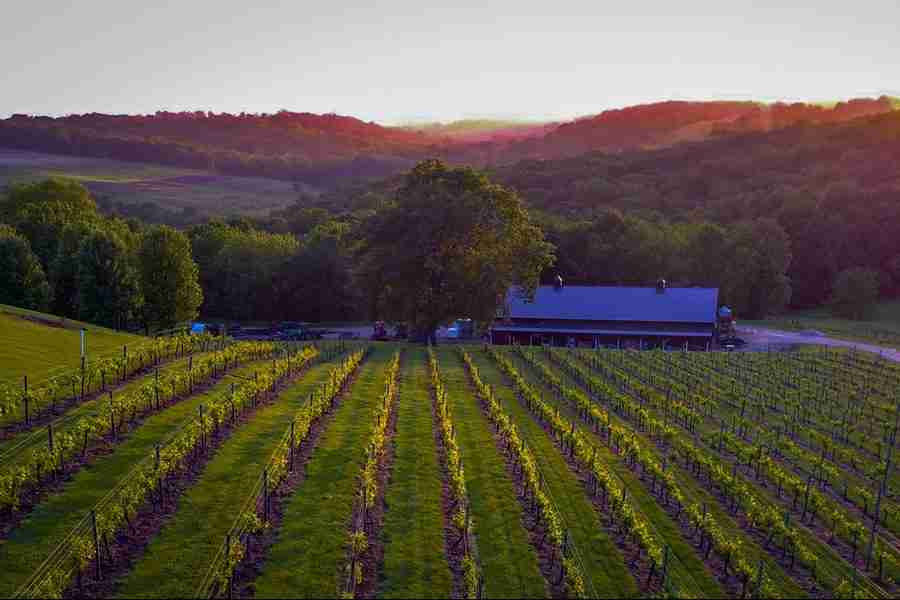How Changing Weather Conditions Have Impacted Park Farm Winery

About Park Farm Winery
It was 2001 when the very first grape vineyard was planted by the Cushman family at Park Farm Winery in Bankston, Iowa, near Dubuque. Located in the rolling hills of the Driftless region of the state—characterized by dramatic bluff country views, winding trout streams, hyper-unique wildlife, and geology— the planting preceded the official opening of the winery there for food, tastings, and wine tours by 3 years in 2004, with a focus on cultivating specialty wine grape varieties that could withstand and thrive within the cold winters of the Driftless climate.
Over the winery’s 21-year history, Jim Cushman— Park Farm Winery’s vineyard manager— has observed many of the same things other grape growers have within the region (and beyond) have when it comes to climate patterns, while drawing his own conclusions. Dealing with Midwestern climate brings a different flavor of challenges to viticulturists than, say, the typical wine-growing fare you’ll find in classic wine regions like Napa Valley.
But the challenges are no less grueling. “[Since our first planting] and during that time, I couldn’t define any specific weather pattern year to year,” said Cushman. “In that time, I’ve experienced drought years, flood years, polar vortex (weather patterns causing uncharacteristically frigid temperatures in winter) and above freezing for weeks in January.
“An average year is the sum of the extremes,” added Cushman.
Specialty wine growers in the Midwest may also deal with severe drought much like vintners out west. But this goes along with a slew of other issues that are atypical of the region, due to changing climate patterns.
Iowa and the Driftless are historically a humid continental climate. This means winters can be predictably frigid, while summers vary between cool and warm, with an overall average temperature of 65˚F.
Observations Over the Years
Cushman’s observations suggest that this is changing. “The past two summers, the growing degree days have accumulated quicker than most years, pushing up the time of harvest,” he said. This is in line with the Farmer’s Almanac predictions for generally hotter summers to become more commonplace in Iowa, along with the increased likelihood of hot weather patterns to occur in wintertime.
“This can be problematic due to the higher temperatures in late August, which can increase spoilage during harvest,” continued Cushman, “and allow ‘unfriendly’ wild yeasts to start fermenting the grapes before we can process them.
“It is also very uncomfortable to hand pick grapes in the heat, which lengthens our harvest,” added Cushman.
The other climate issue an Iowan wine grower deals with, and that may sound alien to western viticulturists: too much rain. Worse, these periods of rain have become overwhelmingly intense over the years, followed by periods of unseasonable drought.
Though several inches of rain may fall within the space of a few hours (in some recent years, up to 20 inches), threatening to damage or wash away crops, even these spells are not substantial enough to break drought conditions. For Cushman, the struggle shows, alternately dealing with both drought and unpredictably hard rains. “Our biggest concern in an ‘average’ year is receiving too much rain at the wrong times.”
Explained Cushman, “When a grapevine is established and the fruit is set in early June, I would ideally like to receive no more than half an inch of rain per week; and after veraison (color change or ripening) even less than that.”
In fact, the dryness is far preferable for grape growing in the Iowan region, no doubt because of the humidity. “Having a dryer than average year in later summer is ideal for the concentration of flavor and sugar in the fruit, as well as not having to worry about pressure from fungus,” said Cushman.
But with wild extremes some years, Cushman and Park Farm Winery have had to go to great lengths to compensate, packing in the extra mile nurturing carefully chosen varieties of wine grapes that can both flourish during Iowa’s short growing season and hunker down during brutal winter temperatures to return in spring— including white and red grape varieties like Marquette, LaCrosse, and Maréchal.
“When we first established the vineyard [in 2001],” said Cushman, “for the first year we had to water the vines thoroughly when planted and again if we did not receive timely rains. This was extremely time consuming, but necessary.”
Looking Ahead
Adding to changing climate patterns, having access to the right tools and technology to accommodate is an added struggle for viticulturists. While some ag tech can be cutting edge for adapting to even the wildest weather patterns, affordability can get in the way. Growers may also ask themselves: is it worth it?
“We certainly could benefit from mechanization but most of the equipment is cost prohibitive,” added Cushman. “Also, most vineyard equipment is extremely specialized and generally comes from overseas, making maintenance a huge consideration. I can’t just pop into the local hardware store or John Deere dealer to pick up a part.
“This is obviously less than ideal in an ag situation where everything is time dependent,” he finished.
For successful Midwest wine growers like Cushman and Park Farm Winery, keeping technology simple in the face of these changes has been the optimal way to go for their vineyard’s size, under 20 acres.
“As of now, we are mostly old school and do the majority of our field work by hand,” said Cushman. For the increasingly new problems facing vintners however, like unpredictable climate patterns and drought, “old school” may not allow them to stay competitive. Ag tech solutions like smart irrigation systems are becoming increasingly sophisticated and affordable, which can make wine growers’ lives much much easier and are far more productive.